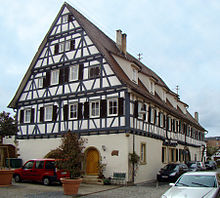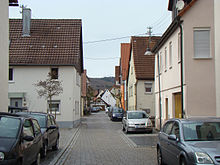Jewish community Freudental
The Jewish community in Freudental in the Ludwigsburg district in Baden-Württemberg existed from the first half of the 18th century and comprised over 40 percent of the town's residents in the mid-19th century. Like many other rural Jewish communities, the community experienced its decline towards the end of the 19th century and became extinct due to the persecution of the Jews during the Nazi era.
history
After Freudental came to Baron Johann Gottlieb Zobel von Giebelstadt in 1710 , he took in the protective Jew Seligmann Wolff from Flehingen with his family of six households in 1723 . The six families were able to build their apartments in the new building known today as the Judenschlössle , the servants' house of the upper castle built in 1614 . In 1727 the place came to Wilhelmine von Würben , a mistress of the Württemberg Duke Eberhard Ludwig , who in 1731 allowed more Jews to settle in the place. The letter of protection of 1731 granted the Jewish community extensive freedom in religious and legal matters, was confirmed in 1747 by Württemberg, which had owned the place since 1736, and influenced several equally liberal letters of protection of the late 18th century for Jewish communities in the area.
A total of 24 families plus rabbis , cantors , grave diggers and Schammes were allowed to settle in Freudental. The Jews settled mainly in Judengasse , today's Strombergstrasse , where the first synagogue was located next to the Judenschlössle . In 1738 the Jewish community already comprised 15 families, in 1757 there were 22 households. The Jewish court factor David Ullmann , who had settled in Freudental with the permission of Duke Carl Eugen , took in other Jewish families on his own initiative, imposed arbitrary taxes on them and left the old synagogue to deteriorate. After complaints from the Jewish community, the Württemberg government finally supported the construction of the Freudental synagogue next to the Judenschlössle in 1770 . In 1811 a second Jewish cemetery (on the Bönnigheimer mark) was created after the first one, which had existed since 1723, had been leveled by King Friedrich von Württemberg in order to build a pheasantry on it.
The Jews from Zaberfeld were also part of the Jewish community in Freudental . Since the rabbi in Freudental was also the arbitration body for other Wuerttemberg Jewish communities in the area that came into being in the 18th century, Freudental became the seat of the Freudental District Rabbinate in 1832 .
In 1851 Freudental had 364 Jewish citizens out of 496 Protestant and 8 Catholic residents. From around 1860 onwards, the size of the community decreased significantly due to emigration and emigration. As early as 1867, the position of the district rabbi was no longer occupied, in 1913 the district rabbinate was dissolved. The Jewish religious school, which had existed since 1816, was also closed in 1920 due to the low number of students. In 1933 there were still 70 Jewish residents living in Freudental.
The relationship between Christians and Jews in Freudental is generally described as good. The Jewish residents were fully integrated and also took seats on the municipal council. Many of the Freudental Jews were cattle dealers. Since the barren soils around Freudental offered hardly any opportunities for agricultural use, jobs in the cattle trade were an important line of business for the entire population.
After the synagogue was desecrated and damaged in the night of the Reichspogromnacht in November 1938, most of the Freudental Jews emigrated by 1939. The last 14 Jewish citizens were deported to extermination camps in 1941/1942. A memorial plaque commemorates the persecuted and murdered Jewish citizens. The former synagogue was preserved and was saved from demolition by a sponsoring association. It now serves as an educational cultural center. At the beginning and end of Strombergstrasse, since 1988 the citizens have been commemorating the centuries-old Jewish settlement of this so-called " Judengasse " until 1933 with two plaques .
Personalities
- Samuel Marum Mayer (1797–1862), lawyer and professor in Tübingen
- Seligmann Grünwald (1800–1856), rabbi and author
literature
- Nebel: History of the Freudentaler Jews , in: Ludwigsburger Geschichtsblätter 34/1982
- Paul Sauer: The Jewish communities in Württemberg and Hohenzollern , Stuttgart 1966, pp. 78–82.
Individual evidence
- ↑ Memorial sites for the victims of National Socialism. A documentation, Vol. I, Bonn 1995, p. 35, ISBN 3-89331-208-0



